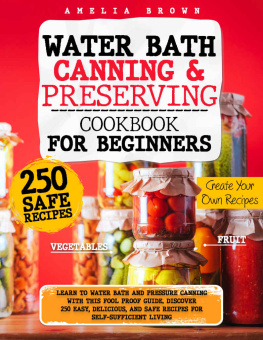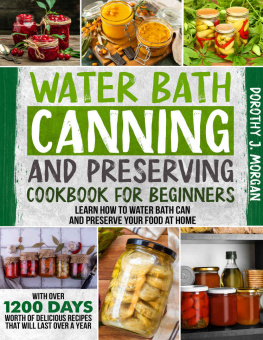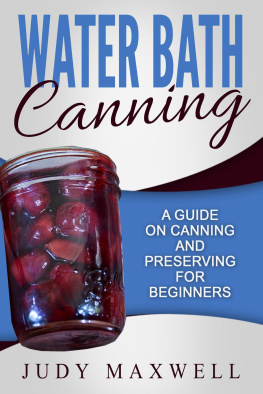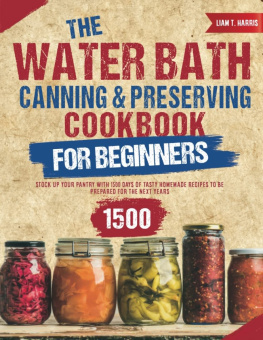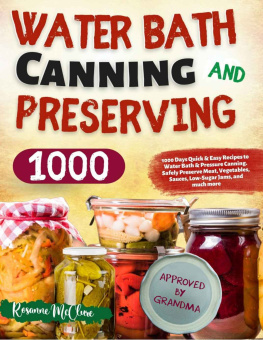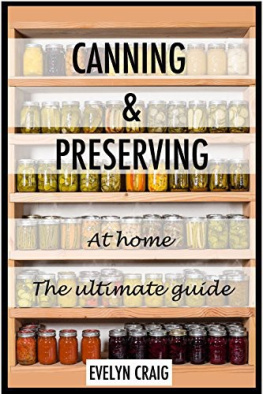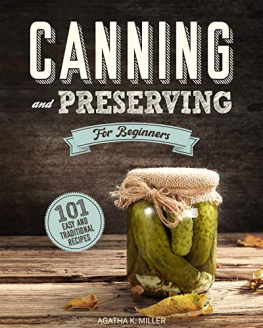WATER BATH CANNING & PRESERVING COOKBOOK FOR BEGINNERS
Learn to Water Bath and Pressure Canning with this Fool Proof Guide. Discover 250 Easy, Delicious, and Safe Recipes for Self-Sufficient Living
Amelia Brown
Copyright 2022 - All rights reserved.
The content contained within this book may not be reproduced, duplicated, or transmitted without direct written permission from the author or the publisher.
Under no circumstances will any blame or legal responsibility be held against the publisher, or author, for any damages, reparation, or monetary loss due to the information contained within this book. Either directly or indirectly.
Legal Notice:
This book is copyright protected. This book is only for personal use. You cannot amend, distribute, sell, use, quote or paraphrase any part, or the content within this book, without the consent of the author or publisher.
Disclaimer Notice:
Please note the information contained within this document is for educational and entertainment purposes only. All effort has been executed to present accurate, up to date, and reliable, complete information. No warranties of any kind are declared or implied. Readers acknowledge that the author is not engaging in the rendering of legal, financial, medical, or professional advice. The content within this book has been derived from various sources. Please consult a licensed professional before attempting any techniques outlined in this book.
By reading this document, the reader agrees that under no circumstances is the author responsible for any losses, direct or indirect, which are incurred as a result of the use of the information contained within this document, including, but not limited to, errors, omissions, or inaccuracies.
Table of Content
Introduction
What is canning?
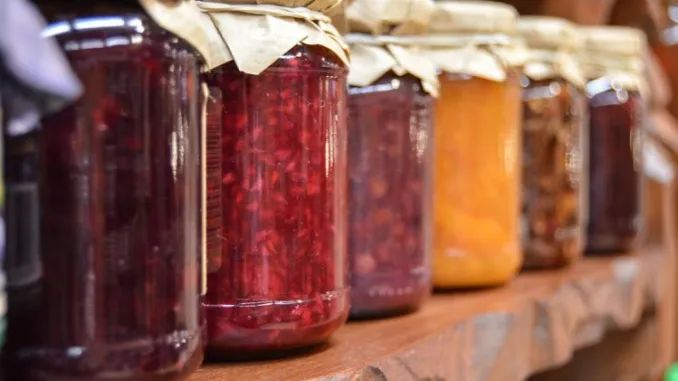
The term canning refers to the canning and preservation process of certain foods. The main foods stored in jars are meat, poultry, fish, vegetables, and fruit.
The canning process occurs in two general stages: Bain Marie canning and pressure canning.
What are the differences between hot canning and cold canning?
Raw (or cold) canning is generally intended for fruit and vegetables, that is, for all those foods that are designed to be stored in jars and where there is no thermal process.
Regarding hot canning, a cooking process is included to eliminate pathogenic bacteria and particular enzymes naturally present in these foods; usually, this process is used for the preparation of foods such as jam, sauces, soups and Prodi, stews, and all foods of animal origin, jellies.
The cooking phase is essential in the preservation of food. In fact, if this step is wrong, in terms of application time and the temperature reaching the core of the food, you risk compromising all the available preserves you want to prepare.
These indications are essential; in most cases, perfect preservation occurs precisely by respecting these parameters.
It is also possible to preserve food in ways other than canning, but here, we will only deal with this type of preservation in this book. So, if you feel insecure or are still not ready to make your own jars, don't worry. Inside you will find a good guide that will help you step by step understand precisely what you will need to do. In addition, you will find many additional ideas to make your food delicious and perfect.
We will start with something relatively simple and then move on to more complex things. But remember, the fundamental parameters during the cooking processes are always the exposure time, and the temperature reached the heart of the jar. For the rest, you don't need to be a real expert, just a little skill in the kitchen and a lot of patience.
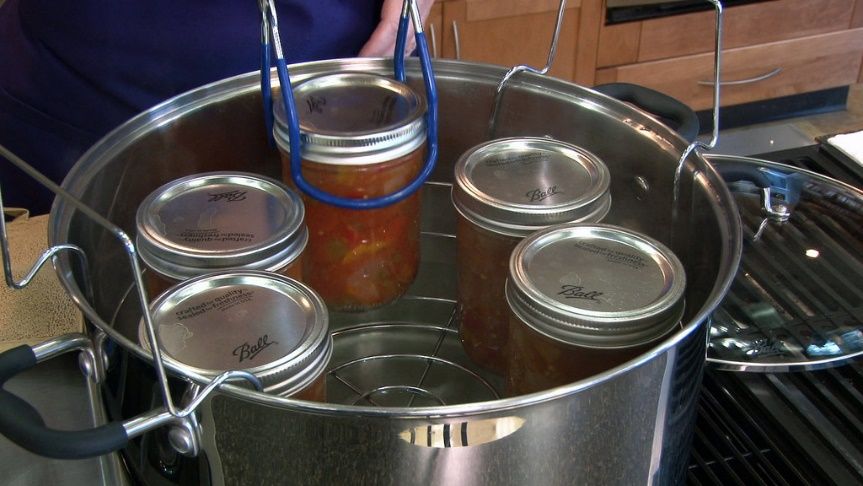
Why canning?
Several scientific studies have shown that canning allows you to preserve the food you want to store for longer. Obviously, for storage, it is not necessary to use a refrigerator. The foods inside the jars typically remain inactive and degrade very slowly. Indeed, we can speak of years.
Furthermore, some scientific studies have also shown that the chemical nature remains almost unchanged. Therefore, these foods retain most of their nutritional and obviously also organoleptic properties.
This aspect is essential for the various conservation techniques. In fact, with necessary and crucial precautions, toxic bacteria (naturally occurring) or their toxins are eliminated.
It is, therefore, essential to follow each step to the letter. With time and experience, you will realize that making a potentially harmful bacteria inactive is a relatively simple job.
Boiling
Take a pan 10 cm taller than the most enormous jars we expect to have to sanitize; a clean and folded kitchen towel must be placed on the bottom. Place the jars on the bottom with the opening facing upwards; place another folded kitchen towel between the pots to prevent them from touching; cover with cold water until it exceeds the ends of the jars by at least 5 cm. Place on high heat until boiling, lower the heat and let it boil for 30 minutes. After the first 20 minutes of boiling, immerse the lids; let cool in the water, then put the jars to dry on a clean cloth with the opening facing down: the last 5 minutes before use, turn them to favor residual evaporation. The presence of kitchen towels is decisive, as the jars tend to move during boiling, and if they collide, they could crack.
Oven
Arrange the jars on a plate and place them in the cold oven with the opening facing upwards. Set the temperature to 338 F with forced ventilation to ensure that the internal temperature reaches at least 320 F in each corner. Once the desired temperature is reached, leave the jars inside the oven for 15 minutes without changing any parameters. Turn off the stove after the necessary time and put the lids on another plate; leave to cool with the door closed. Of course, the dry steam generated by the oven is less effective than the wet one. Still, this method is appreciable for its simplicity of execution.
Microwave
After washing the jars, fill them 1/3 of the way up with cold water and place them on the microwave oven plate. Run at maximum power for 90 or 120 seconds, depending on the cans' capacity, until the water boils; throw the water and let the jars cool on a clean cloth. This technique can only be used for glass jars and not metal capsules, so it is recommended only for containers intended for hot jams to be potted. In this case, direct contact with the high heat source after turning the jars allows direct sanitization of the lid.
Pressure cooker
Place the jars in the pressure cooker following the same precautions suggested for boiling. Cover with water up to 2 cm above the edge of the pots, close with the lid, and place on a moderate flame. Keep the vent valve open to facilitate the escape of air until the very first steam begins to come out, then close the valve. When you hear the whistle of pressure boiling, open the valve again, lower the heat and continue cooking on low heat for 10 minutes. After this time, let it cool to room temperature with the lid closed for obvious safety reasons, then open and continue cooling the jars on a clean kitchen towel with the opening facing down. This sterilization system guarantees excellent results and is particularly suitable for jars with glass lids because, in this way, it is possible to sterilize both in a single step.

